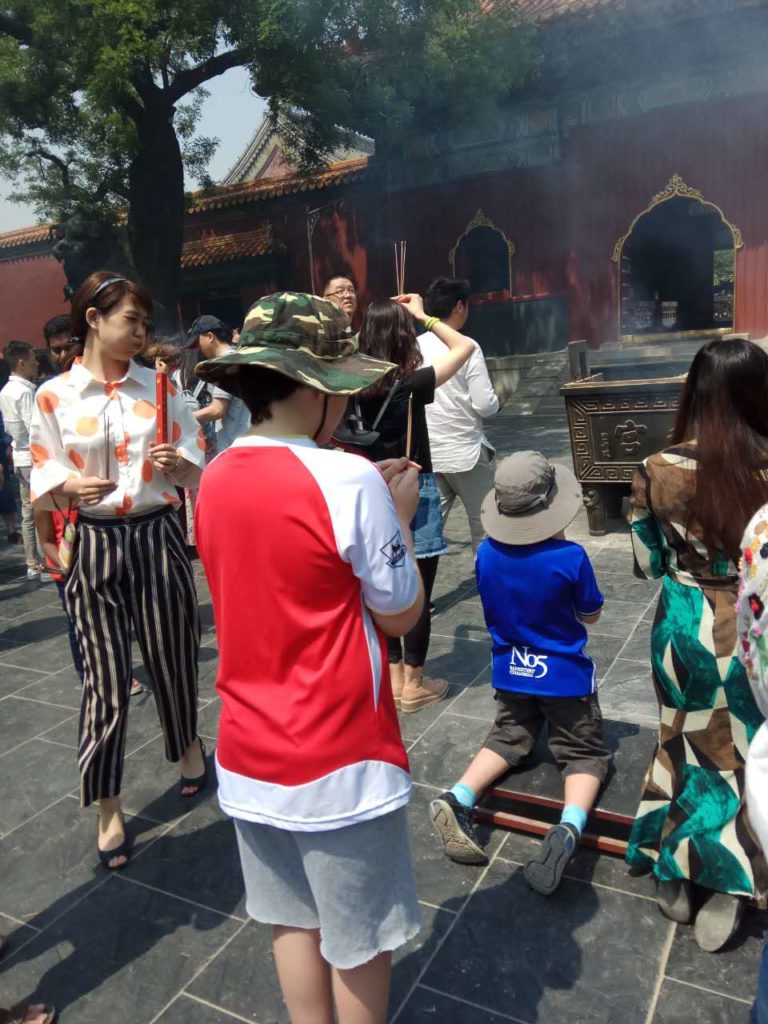Yonghegong Lama Temple is one of the first places we intended to visit when we arrived in Beijing. However my children’s initial enthusiasm was diminished when they realized that it was Lama with one L, not two…
In spite of the lack of llamas we finally managed to drag the boys along there on the May 1 holiday. The Temple itself is situated a short walk south of the eponymous subway station on line 2 or 5 (use exit F, not C as the signs suggest). However it’s more or less the same distance from Beixinqiao.
The complex was built as a palace for Prince Yong (hence the name). Yong became Emperor in 1722, and his son, the Qianlong Emperor, reigned for 60 years, a period often regarded as the Qing dynasty’s peak. It was he who turned the former palace into a lamasery.
The word “lama” reveals that, unusually for mainland China, Yonghegong is a temple dedicated to Tibetan Buddhism, rather than the Chan school which predominates here. The buildings and layout of the site are similar to any other temple, but the statues and paintings within include yab-yum images, wrathful deities with necklaces of skulls, and numerous depictions of Tsongkhapa, founder of the Gelug (or “Yellow Hat”) school of Buddhism.
Yonghegong is also exceptional in that most of the buildings and artworks are original, not modern reconstructions. The complex was protected during the Cultural Revolution, apparently due to the personal intervention of Zhou Enlai, and is now perhaps the best preserved and maintained temple in Beijing.
Another unusual factor is that the entrance fee includes a box of incense, for offering to the Buddha.
The combination of piety and pyromania was irresistible to my boys. However, at the first hall there was a big crowd around the flame from which the sticks are lit, and an attempt to get them burning with a lighter resulted in my wife acquiring a painful blister on her finger. Don’t hustle or hurt yourself over it; there are many other, quieter places where you can make an offering.

Three sticks are plenty for each offering – more risks looking ostentatious. Light them all, then make sure the flame is out. Hold them (above chest height) in the direction of the statue, bow three times, then put them in the big bronze container from which smoke is billowing. Someone asked Noah what he was praying for. “Longevity for all my family,” he said, revealing how deeply he’s absorbed Chinese culture. But it’s a wish more appropriate to a Daoist temple than a Buddhist one; “You should pray for peace,” he was advised.
Yonghegong has five courtyards, each with at least three halls. Most contain statues of Buddhas, bodhisattvas, and lamas, but there are two museums exhibiting treasure from the temple. The eastern hall is more spacious and features sights such as trumpets made from human thighbones and sumptuously embroidered ceremonial robes. To the east a narrow corridor leads you past exhibits with a clear political message, about the symbolism of a Beijing temple’s historic links with Tibet and Mongolia.
The temple’s greatest treasure though is an 18 meter tall sandalwood statue of Maitreya, the future Buddha. It’s so high that you need to walk as far as you’re allowed into the temple to peer up into the roofspace and see the beautifully carved face.
Yonghegong Lama Temple is one of Beijing’s most culturally significant locations, as well as among its most appealing. Even without woolly camelids, it’s still well worth a family day out.
Photos: Karen Killeen, Andrew Killeen




